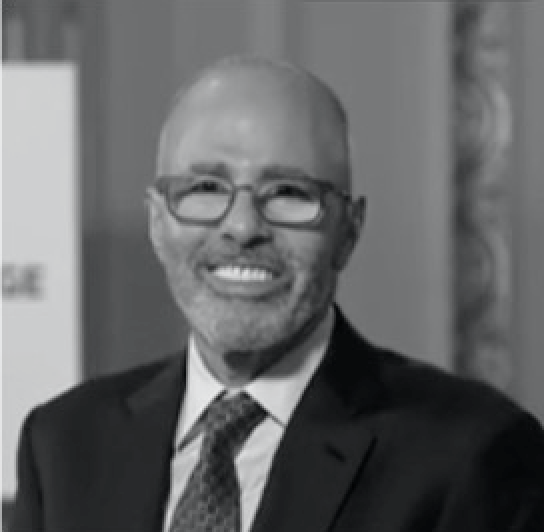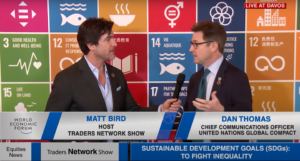Stephanie Carlton from Mckinsey & Company on ‘Era of Exponential Improvement in Healthcare’ at Converge2Xcelerate | Traders Network Show – Boston, MA
Contributed by: Show Editorial Team
Stephanie Carlton, Expert Associate Partner US Health Reform & Medicare for Mckinsey & Company at Converge2Xcelerate Conference (Boston, MA)
HIGHLIGHTS
- Mckinsey & Co. generates an annual revenue of $10 billion
- Carlton: Blockchain is at the center of healthcare revolution
- U.S. is spending 20% of its GDP on healthcare
FULL COVERAGE
INTERVIEW TRANSCRIPTS: Stephanie Carlton, Expert Associate Partner US Health Reform & Medicare for Mckinsey & Company
Stephanie Carlton – Expert Associate Partner US Health System Reform & Medicare, Mckinsey & Co.: 00:10
Good morning. It’s definitely like at technology challenges to kick off a talk on technology driven disruption. It’s great to be with you all this morning. As Tory mentioned, I lead our reform center, which is our research Institute at McKinsey where we sit back and look at healthcare broadly in the United States and then try to integrate it into what we’re seeing day to day as we serve clients across the industry. So it’s with that perspective, I’d love to share a few thoughts. You know, we serve a lot of incumbents in healthcare whether it’s insurers, whether it’s hospitals, whether it’s pharma companies, whether it’s doctors and then watch what is happening over in the technology side of the economy. It’s pretty interesting to think about what would the potential actually look like long-term as we think about US healthcare.
Stephanie Carlton – Expert Associate Partner US Health System Reform & Medicare, Mckinsey & Co.: 01:04
There’s a lot that we’ve gotten right in terms of new technologies that both extend life and improve the quality of it. I think there’s also a lot that we can improve when it comes to healthcare particularly on costs. That comes to mind and you think about the average American pays about as much on healthcare as half of their mortgage payment each month. It continually outpaces economic growth. And so the question that we set out to study was if you really harness the technology that is out there today, how about you change people’s lives when it comes to healthcare outcome and how might for the system broadly, how might you improve the cost picture? So I want to touch on a few things. We look at this from a business perspective. One what are the technology advances that are really affecting profit pools? And for us, that’s a metric of how effective is it? Are people willing to invest in it? And are they actually creating value as a measure of does it really work. Second, I spend just a little bit of time looking at the healthcare focus of three of the big technology giants. And then third, think just a little bit about what are some of the strategic implications that incumbents are thinking through today as they watch all of this.
Stephanie Carlton – Expert Associate Partner US Health System Reform & Medicare, Mckinsey & Co.: 02:29
We do some research every year that looks at profit pools across healthcare. The church that you see up on the screen is a synthesis of all of that. You don’t have to read every little detail of it, but if you look at the size of the box and you look at how dark the color blue is, it gives you a sense of how big the earnings are, how big a stake. You know, that has in that the healthcare economy, obviously hospitals, a pharma and biotech are two of the biggest on the screen, but the darkest blue sections where we see the highest growth above 10% over the last few years and projected over the next couple of years are really in two places. Commercial and government coverage segments. A lot of that is just driven by the affordable care act implementation over the last several years. As you think about the individual market growth, as you think about the Medicaid segment growth, so real high growth segments there.
Stephanie Carlton – Expert Associate Partner US Health System Reform & Medicare, Mckinsey & Co.: 03:27
The other piece that’s really dark blue on this is the space where there’s data and analytics, there’s software and technology. Those we’re seeing more than double digit or double digit growth. So let’s look at just a moment. I’ll take you on a lightning tour through some of these technology advances. You know, we’re seeing across really eight different dimensions, whether it’s from connected and cognitive devices, reading the news over the last week. We’ve now got Medicare advantage companies that are paying for seniors to get an Apple watch as part of their coverage. Seeing the value in that and really take off. Artificial intelligence and machine learning across the board. And I won’t go through this all talking, but I do want to show you a short video on how these things might affect healthcare and what innovators are doing with the technology.
Video Presentation: 04:28
Ingestible and implantable intelligent devices, remote monitoring, drug delivery, solution and cognitive needed with artificial intelligence or nerve stimulation could treat diseases like diabetes, asthma, chronic obstructive pulmonary disease, brought grace, new therapies like cell gene therapy, army therapeutics or Indian therapy have technology. And precision medicine, surgical robotics in cardiothoracic, general surgery, complex urology and magical robotic delivery or in hospital delivery. And that is glass with drones. 3D printing with customers, prostate devices, drug development and tissue engineering, analytics and data trends could make a longitude patient center tell crackers how you targeted and resource and sent optimization. Artificial intelligence can enable diseases, chatbots, predictive interventions and productivity improvements. Launching features, no central control over a database with a distributed ledger and you will record of all transactions, redundant storage across all in the blockchain and Persian access rules-based industry processes, enable workflows, customer service inquiries. All of these four agreements, membership growth tactics and commerce support function packs.
Stephanie Carlton – Expert Associate Partner US Health System Reform & Medicare, Mckinsey & Co.: 06:22
Just a lightning tour through what’s happening out there, what innovator companies are starting or building today. As we’ve looked at all of that that was going on we also double-clicked into our profit pools analysis to see where the value creation lie was specifically in technology. And you see a couple, couple of places in particular that are that dark blue more than 10% growth areas of population health solutions. These are for providers taking on increased risk things where there’s patient and member engagement, trying to engage people more directly in their health. Also places where there’s more provider enablement and trying to really help physicians, nurses be more efficient and effective with the limited time they had. And then a couple other areas I’ll call out all around data and analytics. And some of the information services, those are the highest growth areas.
Stephanie Carlton – Expert Associate Partner US Health System Reform & Medicare, Mckinsey & Co.: 07:22
When we think about value creation in the tech healthcare space. So then we went and looked at what are, what are the big tech players doing when it comes to healthcare? There’s all this innovation that’s out there. How are they thinking about it? Where are they innovating? And we picked three examples. There’s a lot of tech companies that are doing really interesting things, but the ones we picked are some of the bigger ones. You look at what Amazon is doing. And taken together what they’re really building is a distribution ecosystem. If you think about the logistics capabilities they have just as a core company they’re able to offer customers that ability to order things from the comfort of their own homes, which is pretty cool when you start thinking about healthcare and how do you deliver things you know, same day in many cases to a consumer that may need medical supplies or drugs.
Stephanie Carlton – Expert Associate Partner US Health System Reform & Medicare, Mckinsey & Co.: 08:19
Some of the partnerships and companies they’ve been building or buying include PillPack that’s taking a pharmacy ordering and delivery online, again, using their logistics infrastructure and capabilities. Amazon is one of the companies that had this partner to over the last couple of years with Berkshire Hathaway, JP Morgan to start thinking about we’ve got to do something differently when it comes to serving employees and their healthcare. What can we do here? But if you look at what they’re doing, it’s building what we’d call a distribution ecosystem. Apple has a little bit different focus and what they’re building. If you think about Apple, it’s really a smart devices ecosystem. Using their core capabilities. This omnichannel ability where you’ve got an Apple watch that connects your laptop, that connects to your iPhone and allows you to access information anywhere and basically any time.
Stephanie Carlton – Expert Associate Partner US Health System Reform & Medicare, Mckinsey & Co.: 09:20
One of the interesting things that Apple is focusing on is taking that ability to connect with consumers anytime, anywhere. And building an infrastructure that connects with health data systems. They literally have hundreds of partnerships with different hospital groups and different physician groups to help data become much more accessible to patients to access their medical records on their iPhones. You know, that’s really happened over the last couple of years as they’ve developed the technology to quickly pull in that data. It just moves even faster as they know how to do it with one physician group or hospital group and then they start doing it with more. But what pretty interesting when you think about the ability to get a picture of the healthcare consumer, the patient from different providers that they go visit and over long periods of time and really enables the kind of data analysis that you need to start using technology.
Stephanie Carlton – Expert Associate Partner US Health System Reform & Medicare, Mckinsey & Co.: 10:17
And the third I’d just call out is what Google is doing with artificial intelligence facilitated ecosystems. You think about Google’s focus has been to organize the world’s information and they’re using that to better understand the healthcare consumer in their environments, some of their investments with very deep mind Galvani. And that is really focused on how you use artificial intelligence in healthcare to advance what we’re seeing in the life sciences space. So all of these tech giants are focusing on different aspects, different ecosystems within healthcare. As we step back and think about a lot of innovation going on, the tech giants are really making some big moves in healthcare. Taking that together. We would look at maybe four major disruptions on the horizon in the next four, five, six years. We talked about the ecosystems that are more discreet that the tech giants are focused on.
Stephanie Carlton – Expert Associate Partner US Health System Reform & Medicare, Mckinsey & Co.: 11:17
I think what we haven’t seen them focus on or anybody focus on is a fully end to end view of the consumer that connects their data in real time to their ecosystems. More on that in just a moment. Some of the other disruptions that we’d see we could spend hours talking about these but is a radically more efficient medical supply chain. When you think about what Amazon is doing with their logistics infrastructure. Third looking at a modernized transaction and data infrastructure. These are some of the things we’re already seeing possible with blockchain with artificial intelligence and a healthcare efficient system that has traditionally been very fragmented. Technology being able to connect those. I think we see a real potential for disruptions there as well. And then forth, some of the AI technologies and some of what Google’s doing we’d see a much faster and more effective pipeline of therapy development as you’re able to simulate patient conditions and run some of the trials more quickly and accelerate the data and the findings from clinical trials.
Stephanie Carlton – Expert Associate Partner US Health System Reform & Medicare, Mckinsey & Co.: 12:27
Let me focus today and kind of the next 10 minutes at really on that the new healthcare ecosystems and what we see as possible there. But it level sets as we step back and think about the healthcare system, there’s really four that you could see real disruption in the future. So I mentioned what we haven’t seen is an end to end healthcare ecosystem. And by that what I mean is a concept where you take every different dimension of healthcare, consumers life that’s relevant to healthcare, their social care, their home and self-care, the traditional modalities of care where they see a doctor for hospital they’re financing supportive healthcare and their daily life activities. We have an unprecedented level of information available in each dimension. And so we see a real potential to aggregate that data. Have consumers control it centrally and then use data with a technology enabled virtual assistant, if you will that uses artificial intelligence to rapidly monitor real time data to look at historic longitudinal pictures of patient data.
Stephanie Carlton – Expert Associate Partner US Health System Reform & Medicare, Mckinsey & Co.: 13:35
And then to give that information to the healthcare consumers family to their clinical care providers. Given that real time information and then think about, okay, if I’m able to check hemoglobin, I want to see your glucose on a daily basis. How do I respond better and adjust glucose or insulin dosages? You know, and some of these things can be really helpful for chronic conditions. But it’s taking that real time, picture, that holistic picture of a patient and using technology to really create value and better serve those patients often in the setting of their own home. That might’ve just been previously available. In a co a high cost facility. You think about the, the focus of those ecosystems and where they could really be tailored. The first population group we would see are some of the population that’s just healthy or there may be a well-managed chronic condition.
Stephanie Carlton – Expert Associate Partner US Health System Reform & Medicare, Mckinsey & Co.: 14:3
And there’s a lot of that that is actually going on today. In early stages with the Apple watches. They’re able to use EKG at any time of the day and the lives that could be affected by that. We’d estimate 200 to 250 million Americans and a lot of spend that’s affected by that. Second, we see this could be a separate focus for individuals who have high needs and multiple comorbidities that you could design things where you’re really connecting those consumers to their caregivers, to their clinicians on a real time basis and being able to flag when there might be a predictive event that an intervention could avoid a high cost facility stay. And then the last category we would see you could tailor things to is how do you use it for a specialty chronic condition. And you could see if for somebody with cancer, how do you use their medical history and some of their genetic information to figure out what’s the right cancer therapy for their specific profile and think about using different data pieces but more holistically for those patients. So we kind of stepped back and looked at taking these things together. What really might healthcare look like in the future?
Video Presentation: 15:54
We all want money from our healthcare system here. Isn’t always available when you need it. And information that is available isn’t always reliable and doesn’t know you and more medical history to people may not end up in the right place with the right provider receiving, seeking the right care at the right time. Just imagine how this could be better. Smart devices actively monitor your vital signs. AR growers, you stay in to identify potential areas of concern and gauge the level of severity. Patients with ongoing conditions could have additional monitoring devices prescribed for them to translate data critical to a remote diagnosis. Meanwhile, system identifies the best available provider based on the patient’s current condition and needs. Telemedicine provides unmet human analysis, physician comfort in a more immediate and convenient way and the physician, the patient’s health history, we can inform the houses and enabling a more holistic treatment recommendation and of course of action with seamless delivery without the need for in person is and things are definitely from the patient’s account as part of her care subscription.
Video Presentation: 17:24
Well, this may sound like science fiction, the technology that will power the future is already here to accelerate. Consumers have shown me are willing to quickly adopt new technology when it makes their life easier. In fact, it gets harder to imagine living without technology that didn’t exist just a 10 or 15 years ago. As consumers expectations on us, Hilton man, better services, healthcare we will be next and the impact for consumers could be enormous in some of the most critical aspects of their lives. Suffers from an innovation gap. In most cases you still have to go to a location for treatment that shouldn’t require an in person visit, which do services online and office customer friendly hacks. Some it’s going to capture this opportunity in life. Many organizations are already taking action. The journey to a new tomorrow, starts with decisions we make today. Where will you be in 2025?
Stephanie Carlton – Expert Associate Partner US Health System Reform & Medicare, Mckinsey & Co.: 18:48
So as we looked at all of this and the potential I think the concept of the ecosystem as one of the more potentially disruptive innovations that we’d see that the top technology exists to create. We just haven’t seen anybody put it all together quite yet. There’s tremendous potential to really improve patient lives and the quality of care. One of the questions we started out with is what are the implications for cost in the US healthcare system? So we’ve set out to look at what’s really the potential of all of these technologies taken together to reduce healthcare costs or at least to create value that can be changed in the healthcare system. And what we did is took a use case approach. We looked at the different things you could do with these technologies, where their case examples today and then built it out to broader, broader adoption throughout the healthcare system and then looked at what would the net value creation be to the US healthcare system.
Stephanie Carlton – Expert Associate Partner US Health System Reform & Medicare, Mckinsey & Co.: 19:47
Do give you an example of one of them. We went and looked at the top 10 chronic conditions. What is the spend there and what is the variability and adherence to medical evidence that you see in the care of those populations. And looked at what do we believe technology could do to really increase adherence to medical evidence for those populations. So we went and say as that total spend looked at how much we believed you could reduce the variability by using technology to get people the right care more quickly and more effectively. And it was those kinds of a very specific use case approach built on what’s possible today and that we got to by 2025 valuation of about 350 to 410 billion. And if you put that in context of what we’re expected to spend as a country in 2025, it actually brings healthcare costs in line with economic growth.
Stephanie Carlton – Expert Associate Partner US Health System Reform & Medicare, Mckinsey & Co.: 20:42
And so at some level, if we’re able to achieve this technology disruption the potential is there to, to really get a handle on healthcare costs in the United States. I think the math proved it is possible. It’s a very different question. What will innovators, what will incumbents actually do about it? I think there’s a lot of questions that we have in our minds about what is the level of urgency particularly for incumbents who make so many of the decisions today. Are they going to see the changes is evolutionary? Are they going to be making big bets to really see revolutionary change? Second, how will you know you’re big health insurers partner with some of the tech companies? Are they going to be seen as friends to partner with or foes to compete with that can really disrupt business models?
Stephanie Carlton – Expert Associate Partner US Health System Reform & Medicare, Mckinsey & Co.: 21:34
And then third, I think a question in our minds is how will incumbents that make most of the decisions today leverage their strengths and make themselves indispensable? For example, through local market density or the brands that they’ve got. I think all of these are questions we don’t have the answer to today. I think there are questions that incumbents are or maybe should be asking themselves about what to do with the technology potential that we’re seeing today and how it’ll change healthcare longer term. And it’s a question I would just leave each of you with as you’re here having conversations over coffee and lunch about, where do you see the real potential, where do you see the value creation? What are the barriers to that? Whether they’re regulatory, whether it’s change management, whether it’s payment structures, and what do we do about changing those barriers and making progress. So hopefully it is a day full of rich discussion and provoking ideas and really appreciate you letting me be with you to start the day.
For Link to Original Article, Click Here
All rights reserved to the Traders Network Show. No part of this publication may be reproduced, distributed, or transmitted in any form or by any mean including; photocopying, recording, or other electronic or mechanical methods, without prior written permission of the publisher, except in the case of brief quotations embodied in critical reviews and certain other noncommercial uses permitted by copyright law. For permission requests, write to the publisher addressed “Attention: Permissions Coordinator”








